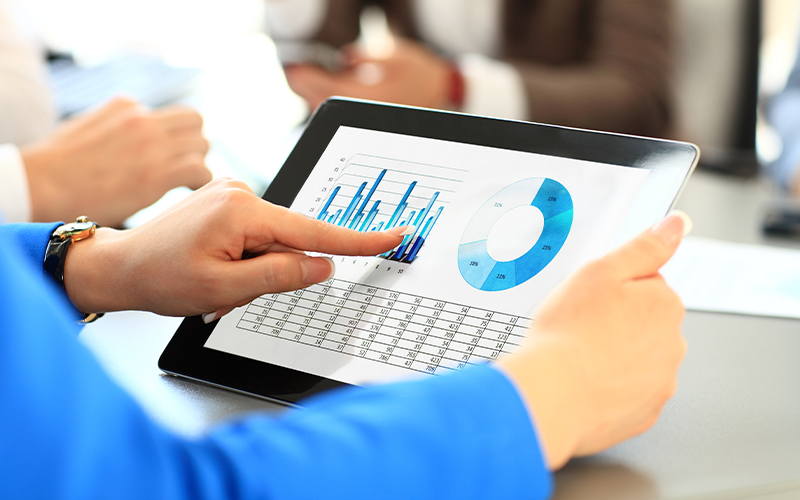Procurement processes especially spend analytics is critical for growth and profitability. But do you know how the spend analytics of your business is faring against that of your peers or the industry standard? If not, spend analytics within your business may be operating in a bubble without maximising its potential.
This blog will explain the importance of spend analytics benchmarking, essential key performance indicators (KPIs), and how it can benefit your business.
What is meant by benchmarking spend analytics performance?
Benchmarking the spend analytics performance means comparing it with the performance of other businesses within or outside your industry. You can use spend analysis dashboards to identify your strengths and weaknesses, gaps, and opportunities by doing so. Learn from industry standards and innovations and adapt accordingly.
Benefits of benchmarking spend analytics performance
By using benchmarking in spend analytics, you can meet goals, build value, and get the desired ROI. Here is a list of the benefits you can get out of benchmarking a spend analysis report –
Higher effectiveness and efficiency
Use benchmarking of spend analytics to identify areas that need internal improvement. See if your current KPIs are improving over time and compared to those of other companies. Get insights on how to make your processes efficient and effective.
Set clear goals
Regular spend analytics benchmarking lets you develop measurable business goals for which you can set up an action plan. Once you know the business goals, you can develop impactful and innovative business strategies.
Discover opportunities
Spend analytics benchmarking helps you find new opportunities to grow your business by understanding the KPIs you need to prioritise to remain successful. Develop strategies to boost performance and leverage the new opportunities to your advantage.
Evaluate the efficacy of your procurement solution
Assess if your current procurement solution is helping you achieve the business objectives. Your next logical step could be to either improvise, reconfigure, or replace the current solution for better internal controls.
Key metrics to benchmark spend analytics performance
Although the metrics will depend on your industry and business, some of the common ones are mentioned below –
Number of suppliers
Compare the number of suppliers you deal with to the industry average and best practice. You could have single or multiple suppliers for a single item. Consider having more than one supplier for critical items or services to reduce the risk during times of limited supply.
Purchasing from too many suppliers may reduce opportunities to get discounts, impacting your bottom line. Benchmark the supplier KPIs with those of your competitor businesses to know the ideal number of suppliers to work with.
You can further analyse the total spend per supplier, price variations, and the frequency of spend. Using this KPI, you can shortlist the top suppliers and increase your negotiating power.
Spend under management
This is the percentage of total spend under procurement. You can define policies within the procurement software you can reduce wasteful spending. Some of the actions you can take are –
- Review the authorising personnel within the system.
- Update the internal controls and delegation authority.
- Automate the alerts for non-compliance.
- Configure a vendor approval process.
- Define potential risks at decision points.
- Configure additional approvals on crossing spend thresholds.
- Review audit trails.
Cost savings
Track cost savings as you fine-tune the procurement strategy and curb rogue spend. Practice minimising the cost, collaboration, and relying on a request for quotation (RFQ) to purchase goods at the best price. Strategically consolidate the suppliers and purchase orders to save shipping costs and get the best deals and volume discounts.
Contribution to total spend
Break down the total spend into separate areas to analyse the areas for cost savings and monitor the relevant KPIs. Analyse the spend by employees, suppliers, projects, budgets, transactions, and departments or cost centres.
This data based on KPIs is much more valuable than spreadsheets as it helps you understand what your employees spend daily. You can negotiate a new contract with another supplier or consolidate the orders to gain more negotiating power with one supplier. You can introduce templates for repeat purchases and fast-track the approvals through standard workflows.
Cycle times and costs
Calculate the procurement and accounting cycle times and costs and compare them with the industry standards. You can monitor the following cycle times –
- Purchase order and invoice.
- Expense to reimbursement.
- Average acquisition approval.
- Transactional costs to process purchase orders and invoices.
For example, in the benchmarking data, the optimal purchase cycle for top performers is 5 hours. Underperformers take as long as 48 hours.
Procurement ROI
Know the ROI that your procurement operations generate by subtracting your department’s costs from the total financial and operational savings. This metric gives you a strong indication of the department’s performance and increases its value.
For organisations on the digital transformation journey, agility is key in responding to a rapidly changing technology and business landscape. Now more than ever, it is crucial to deliver and exceed on organisational expectations with a robust digital mindset backed by innovation. Enabling businesses to sense, learn, respond, and evolve like a living organism, will be imperative for business excellence going forward. A comprehensive, yet modular suite of services is doing exactly that. Equipping organisations with intuitive decision-making automatically at scale, actionable insights based on real-time solutions, anytime/anywhere experience, and in-depth data visibility across functions leading to hyper-productivity, Live Enterprise is building connected organisations that are innovating collaboratively for the future.
How can Infosys BPM help?
Procurement and spend analytics are important components of an organisation’s holistic digital transformation. Infosys BPM uses AI and ML technologies for data ingestion, cleansing, and de-duplication.
Companies can classify spend according to the United Nations Standard Products and Services Code (UNSPSC) or a custom taxonomy. Thereafter, you can identify new opportunities and take actionable insights.
Read more about spend data analysis at Infosys BPM.








